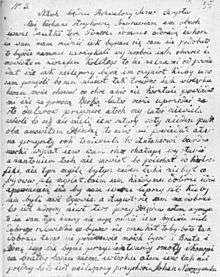Texas Silesian
| Texas Silesian | |
|---|---|
| teksasko gwara | |
| Native to | United States |
| Region | Panna Maria, Texas |
| Ethnicity | Silesian Americans in Texas |
| Language codes | |
| ISO 639-3 |
szl |
| Glottolog |
sile1253[2] |
| Linguasphere |
53-AAA-cck, 53-AAA-dam |
Texas Silesian (Silesian: teksasko gwara) is a dialect of the Silesian language used by Texas Silesians in American settlements from 1852[3] to the present. It is a variant of Silesian derived from the Opole dialect. The dialect evolved after Silesian exile around the village of Panna Maria.[4] It contains a distinctive vocabulary for things which were unknown for Polish Silesians.[5]
Texas Silesian is lesser influenced by German because its speakers emigrated before the Kulturkampf, which added a lot of germanisms to the continental Silesian[6] The language is tended by its speakers, but they know it only in the spoken form.[6] Texas Silesian has not been replaced by English because the Silesian community is strongly isolated.[7] Nevertheless, Texas Silesian has adopted some words from English.
One of the characteristic features of Texas Silesian phonetics is called mazuration, in which all cz, sz, ż are pronounced [t͡s, s, z], whereas in the stereotypical Silesian of the Katowice urban area they are pronounced [t͡ʂ, ʂ, ʐ]. Texas Silesian has given the name for Cestohowa village in Texas - the name is derived from Polish Częstochowa, but, due to this phonetic process, cz became c.[5]
Typical words unlike Silesian
| Texas Silesian | Silesian | English |
|---|---|---|
| turbacyjo[5] | ńyprzileżytość | problem |
| zaszanować[5] | zaszporować | to save money |
| kapudrok[5] | zalůńik | frock coat |
| furgocz[6] | fliger | aeroplane |
| szczyrkowa[5] | no native word | rattlesnake |
| po warszawsku[5] | po polsku | in Polish |
| prastarzik[5] | starzik, uopa | great-grandfather |
| ćeżko[5] | fest | very |
| kole tego[8] | uo tym | about that |
| pokłoud[6] | gipsdeka | ceiling |
| bejbik[9] | bajtel | baby |
| kara[9] | autok | car |
| wjater[9] | luft | air |
| korn | kukurzica | corn |
| farmjyrz | gospodorz | farmer |
| plumzy, piczesy | fyrcichy | peaches |
| garce | buncloki | pots |
References
- ↑ "Ethnologue report for language code: szl". Ethnologue. Languages of the World.
- ↑ Hammarström, Harald; Forkel, Robert; Haspelmath, Martin, eds. (2017). "Texas Silesian". Glottolog 3.0. Jena, Germany: Max Planck Institute for the Science of Human History.
- ↑ http://www.tshaonline.org/handbook/online/articles/hlp04
- ↑ "Telewizja TVS". Retrieved 5 March 2015.
- 1 2 3 4 5 6 7 8 9 "RADIO COURIER". Archived from the original on 3 November 2007. Retrieved 5 March 2015.
- 1 2 3 4 "Archived copy". Archived from the original on 2009-12-21. Retrieved 2009-01-27.
- ↑ http://www.niedziela.pl/artykul_w_niedzieli.php?doc=ed200813&nr=2
- ↑ "ŚLŮNSKO EKA - Ze gyšychty našyj godki". Archived from the original on 6 March 2008. Retrieved 5 March 2015.
- 1 2 3 "Inne". katowice. Retrieved 5 March 2015.
